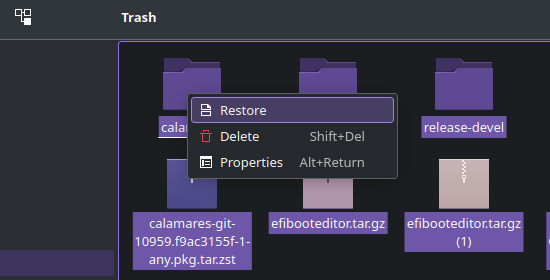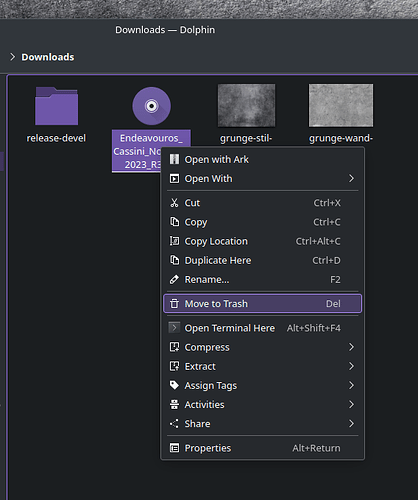my external disk is mounted on home. so i right-clicked my “diskx” folder on kde dolphin and then fat-fingered the delete button. turns out all and any data on the disk is gone. 500 gb down the drain!
the info i find on arch wiki and here looks contradictory (im ignorant) so to not further f*** it up, here is some data:
-
i haven’t written new data. disk is still empty.
-
i rebooted my pc. i don’t know in what cases this is bad but i did.
-
hardware is fine
-
it’s an ext4. haven’t re-formatted it
and finally, i don’t have where to store a 500 gb backup. otherwise i wouldn’t be having this problem. i though i had but, long story short, i don’t.
Not sure if that is possible without a third party app.
I suggest this one: https://recoverit.wondershare.com/
Edit:
This video shows how it works:
usually this is something for the professionals… Data recovery is not easy.
And without any extra drive that can at least hold an image copy of your drive… i do not see how you could recover safely.
There are some tools to recover partitions like testdisk, but i am far from recommending to play with it without any backup of your drive.
And 99,99% of the third party apps will not allow to recover any data without payment …
1 Like
let’s say i get a drive. how should i proceed?
I fat-fingered my g/f’s work usb…oh boy did I have to pay…used ‘easeus’ company.
How: installed their program (exe only) to a windows machine. plugged in usb to that windows machine.
recovered 99% of that usb,
first create a backup image so you can leave the original drive untouched… using ddrescue p.e.
If you have done that you can use the image file mount it and try recover data from that in case it fails you still have original drive and indeed you can backup the image file…
Also what you exactly “clicked” to delete the files? usually filebrowser do put files into trash, from there you can recover (replace) the deleted files back to its place as long as you do not empty the trash.

right-click, then delete, like in the image you linked. only difference is i was in home dir, not trash. a pop-up shown saying “deleting failed” and when checked the disk, it was empty. trash was empty too.
The biggest thing is not do anything to the drive as it will overwrite what is there. As @joekamprad said you need to create a backup image and leave the original untouched. I’m not an expert but i know from experience as i have used testdisk before to try to recover 10 years of files that were destroyed when a student took a usb drive home and plugged it into an xbox which tried to format it. The problem was that someone else had already messed with it numerous times. I tried as a last ditch effort. I was able to recover a lot of the files but many were corrupted. It did help to some degree but mostly everything was missing many parts due to corruption of those files. It was hard lesson learned. Best to get an expert that knows what they are doing if the data is important.
per default dolphin does not offer right click delete option … this is only showing up inside trash… same like empty trash… default is only “Move to Trash”
You can hold Shift while this menu is opened then trash will change to permanent remove
2 Likes
ah yes (me not really using kde) forget about that.
It’s not the best choice for that … Sausage fingers ahead … directly neighbor of Ctrl…
Anyway poster already mentioned that the trash is empty… so it is a thing about recover the data and nothing we can reset easily…
Take the disk on which data loss occurred to a data recovery professional. Do not attempt to recover it yourself, the chance of permanent data loss is about 99%, especially if you need instructions from a forum. Do not even connect the drive to check if it is empty, not even for a second. If you must, make sure you mount it as read-only. File managers seemingly unpredictably write data to drives, to store things like folder icons and image thumbnails. This is enough to corrupt a lot of deleted data, which could otherwise be recoverable.
Use the new drive you got for backup, so that this doesn’t happen again. And if you want to do data recovery yourself, practice on data that you can afford to lose, in a situation where there is no pressure, nor expectation of success. Learning to do data recovery on a drive on which you’ve just experienced a major data loss is generally a terrible idea.
2 Likes
And btw, just to add: IF you would try to do it by yourself, get a second drive and do a bit-for-bit copy (for example via Clonezilla) and then work ONLY on the copy. Doing it that way you can rtry by yourself and if you fail you can go the expensive way.
What you are currently learning the hard way is the old rule: no backup = no data. Feel sorry for you 
Yes, but even that is bad advice, because there are many ways one can screw this up. For example, by not mounting the drive properly (and just plugging the drive in a USB port can cause some auto-mount procedure to run…). If the data is important, and you don’t know what you are doing, take it to an expert. I’m almost sure you’ll destroy the data if you try it yourself, without prior experience.
2 Likes
Mind the uppercase “IF” - and yeah, you are right, but if one would go the Clonezilla way than Clonezilla would care for the correct, non-harmfull mount - this is the main reason why I like Clonezilla so much. Nevertheless, I lost data in the past in similar manner, and nowadays I have a 3-tiered Backup running… The experience was to scary.
I’m 100% there with kresimir…
You will by a 99% chance loose the data on personal attempt to recover the data.
And as a reminder … thinking about a Picture folder got 150.000 pictures in several sub folders with filenames … recovering with most free tools will may work to recover the raw images but not with filenames or folder structure… it will also make no difference from icons and photos… all mixed up…
I have done some data recoveries in my live i know it can work but always first rule do not touch the drive, do not mount it… create a raw image copy of it and work with the image instead of the original drive… make a copy of that image and use this to recover… in case you will need a lot of space to do all this and a lot of time…
Professionals have better knowledge and better tools and special devices to handle this.
In case the data is of great importance, pull out the drive and let professionals recover it…
3 Likes
Yeah, I don’t like that idea, not even if it is under a huge “IF”, sorry.
I intentionally refuse to give any tips or advice how to do it, for two reasons:
- I am not an expert, there is probably a bunch of things I’m missing.
- I don’t want to give any hope that it is possible to do it yourself. It is not, unless you are astronomically lucky.
You have to consider the psychology of the situation. We all know what it feels to lose data. It’s a terrible feeling. The cold sweat, the weakness in the knees, the tears in the eyes… “I can’t believe I just did that!” And panic! Lots of panic: “I just lost a lot of precious data, I gotta do something about it, [look up how to do data recovery find some fraudulent tool or something]”. I’ve seen it a million times, people do stupid things in panic, and make the situation irreparable. Even if you have 100% accurate and complete guide on how to do it, and even if it comes with a huge disclaimer, the chances of success are negligible. And people who just experienced data loss are desperate and will grasp at any straw for even the slightest hope of recovering that data. Ironically, this will cause their data to be permanently destroyed.
If you’ve never done it, if you need to ask about it on a forum, no, there is no hope that you’ll do it correctly. I don’t want to be responsible for such hope, because the only result of that hope is the destruction of data. The best advice I can give is to forget about any data recovery tools, forget about Clonezilla or anything else. The only realistic chance you have at recovering it is to take it to an expert. Otherwise, that data is gone, just accept that and move on.
3 Likes
IF someone would try it for himself (maybe most of the data is not that important?) and IF that someone is feeling risky this would be one way. I did it, and it saved me, and yeah, it was my first.
Nevertheless, if the data is important, get to the guys of ontrack or seagate and ship the device. They will get the device, do their magic, will send you an except of what they can recover and than they will bill you - if the amount is to high, they will ship it back to you and all you pay are twice the shipping cost. That would actually be my advice.
1 Like



